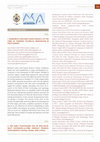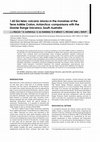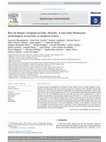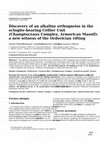Papers by Ramon Capdevila

Comptes Rendus de l'Académie des Sciences - Series IIA - Earth and Planetary Science, 2000
A 1 200 km-long linear magmatic belt extends along the Mediterranean coast of the Maghreb from Ea... more A 1 200 km-long linear magmatic belt extends along the Mediterranean coast of the Maghreb from Eastern Tunisia to Morocco. This belt is mainly composed of Langhian calc-alkaline metaluminous to peraluminous granitoids and associated andesites/ dacites in Central and Eastern Algeria. In Tunisia and Oranie/Western Morocco, calcalkaline activity started later (during the Serravallian) and was followed by the emplacement of alkali basalts and basanites since the Tortonian to the Pliocene and, in some places, the Pleistocene. Available data on the tectonic setting, petrology, age and geochemistry of this belt show that most of its striking features, e.g. (1) very low magma production rate, subduction-related geochemical imprint, extensive crustal contamination for the calc-alkaline magmatism and (2) progressive magmatic change from calc-alkaline to alkaline, are consistent with magma generation during a slab breakoff process as proposed by . The magmatism associated with this breakoff started in Central Eastern Algeria at 16 Ma, then propagated eastwards and westwards. The upward flow of asthenospheric enriched plume-type mantle through the tear in the downgoing slab first triggered melting of the overlying lithospheric mantle which had been metasomatised during a previous subduction period. Heat supply from this uprising asthenosphere may have warmed up the continental crust and made its involvement in assimilation processes easier. As the asthenosphere ascended through the 'window' in the slab, partial melting occurred at the uprising boundary between asthenosphere and lithosphere, generating basalts with transitional characteristics between those of calc-alkaline and alkaline basalts. As the asthenospheric upwelling proceeded, partial melting then occurred in the sole asthenospheric mantle, producing alkali basalts. © 2000 Académie des sciences / Éditions scientifiques et médicales Elsevier SAS breakoff (slab) / magmatism / calc-alkaline / alkaline / Neogene / Maghreb * Correspondence and reprints to: maury@univ-brest.fr 159 C. R. Acad. Sci. Paris, Sciences de la Terre et des planètes / Earth and Planetary Sciences 331 159-173 © 2000 Académie des sciences / Éditions scientifiques et médicales Elsevier SAS. Tous droits réservés S1251805000014063/REV Résumé -Le magmatisme néogène post-collisionnel de la marge méditerranéenne du Maghreb : une conséquence de la rupture de lithosphère subduite. La marge septentrionale du Maghreb comporte une chaîne magmatique, qui s'étend sur 1 200 km des Mogods (Tunisie) à Ras Tarf (Maroc). En Algérie centrale et orientale, elle se compose principalement de granitoïdes métalumineux et peralumineux langhiens et d'andésites et dacites calco-alcalines associées. En Tunisie, en Oranie et au Maroc, l'activité calcoalcaline débute plus tard, au Serravallien. Elle est, par la suite, relayée par un magmatisme alcalin d'âge Tortonien à Pliocène et, localement, Pléistocène. La synthèse des données tectoniques, géochronologiques, pétrologiques et géochimiques disponibles nous permet de montrer qu'un processus de rupture de lithosphère plongeante proposé par Carminati et al. en 1998 rend compte de l'essentiel des particularités magmatiques de cette chaîne (comme le très faible taux de production magmatique, l'empreinte géochimique de subduction des roches calco-alcalines et la forte contamination crustale qu'elles ont subie, ainsi que la transition calco-alcalin-alcalin au cours du temps). Le magmatisme lié à cette délamination lithosphérique a débuté vers 16 Ma en Algérie centrale et orientale, puis s'est propagé vers l'est et vers l'ouest. Le flux ascendant de manteau asthénosphérique enrichi (de type panache) au travers de la déchirure lithosphérique a d'abord provoqué la fusion du manteau lithosphérique sus-jacent, métasomatisé lors d'une période antérieure de subduction, ce qui a entraîné la formation de magmas calcoalcalins. Ce flux asthénosphérique a également contribué à réchauffer la croûte continentale, facilitant ainsi son assimilation par les magmas d'origine mantellique. Par suite de la remontée progressive de l'asthénosphère dans la déchirure lithosphérique aux deux extrémités de la chaîne, la fusion partielle s'est produite à la limite lithosphère-asthénosphère, engendrant des magmas basaltiques, dont la signature géochimique est transitionnelle entre les types calco-alcalin et alcalin. Consécutivement à l'élargissement de la déchirure lithosphérique, la remontée asthénosphérique s'est poursuivie ; la fusion partielle s'est alors exercée dans le seul manteau asthénosphérique enrichi, produisant des liquides basaltiques alcalins. © 2000 Académie des sciences / Éditions scientifiques et médicales Elsevier SAS

Lithos, 2001
In NE China, voluminous granitoids were emplaced in late Paleozoic and Mesozoic times. We report ... more In NE China, voluminous granitoids were emplaced in late Paleozoic and Mesozoic times. We report here Sr -Nd -O isotopic and elemental abundance data for two highly evolved granitic plutons, Woduhe and Baerzhe, from the Great Xing'an Mountains. They show a rather ''juvenile'' Sr -Nd isotopic signature and a spectacular tetrad effect in their REE distribution patterns as well as non-CHARAC (charge-and-radius-controlled) trace element behavior. The emplacement ages are constrained at 130 ± 4 Ma for the Woduhe and 122 ± 5 Ma for the Baerzhe granites by Rb -Sr and Sm -Nd isotope analyses. Both granites are also characterized by low but imprecise initial 87 Sr/ 86 Sr ratios of about 0.703. The Nd -Sr isotope data argue for their generation by melting of dominantly juvenile mantle component with subordinate recycled ancient crust. This is largely compatible with the general scenario for much of the Phanerozoic granitoids emplaced in the Central Asian Orogenic Belt. The parental magmas for both the Woduhe and Baerzhe granites have undergone extensive magmatic differentiation, during which intense interaction of the residual melts with aqueous hydrothermal fluids (probably rich in F and Cl) resulted in the non-CHARAC trace element behavior and the tetrad effect of REE distribution. Both the Woduhe and Baerzhe granites show the characteristic trace element patterns of rare-metal granites, but their absolute abundances differ by as much as two orders of magnitude. The oxygen isotope compositions of the two granites have been severely disturbed. Significant 18 O depletion in feldspar, but not so much in quartz, suggests that the hydrothermal alteration took place in a temperature condition of 300 -500°C

Barranco León and Fuente Nueva 3 (Orce, Andalusia, Spain) are well established as major archeolog... more Barranco León and Fuente Nueva 3 (Orce, Andalusia, Spain) are well established as major archeological occurrences in the framework of Old Europe. Situated in southern Spain's Guadix-Baza depression, they provide an exceptionally rich and well dated record for the earliest human presence in Europe (1,4-1,3 Ma, respectively). Since 2008, renewed excavations and inter-disciplinary research conducted at the sites have considerably enlarged the artifact register, providing new lines of research in the fields of lithic technology and typology. Renewed interests focus on variability within the range of local raw material procurement patterns and also on the structural analysis of intra-site transmission of technological knowhow in the context of pioneering hominin groups in Europe. The context of the sites: on the shores of a paleo lake, and the evidence for the presence of other large carnivores, underline questions of expedience as an influence on techno-morphology in early stone toolkits. We propose an analysis of these themes, with an accent on updated information from these and other key sites situated in Europe and dating to the late Early Pleistocene. ORAL 2. THE EARLY PLEISTOCENE SITE OF BOIS-DE-RI-QUET (LÉZIGNAN-LA-CÈBE, HÉRAULT, FRANCE): STRATIGRAPHY, DATING, FAUNA, AND LITHICS Bourguignon, Laurence (Inrap AnTet/Arscan, Pôle mixte de Recherche, Domaine de Château

Barranco León and Fuente Nueva 3 (Orce, Andalusia, Spain) are well established as major archeolog... more Barranco León and Fuente Nueva 3 (Orce, Andalusia, Spain) are well established as major archeological occurrences in the framework of Old Europe. Situated in southern Spain's Guadix-Baza depression, they provide an exceptionally rich and well dated record for the earliest human presence in Europe (1,4-1,3 Ma, respectively). Since 2008, renewed excavations and inter-disciplinary research conducted at the sites have considerably enlarged the artifact register, providing new lines of research in the fields of lithic technology and typology. Renewed interests focus on variability within the range of local raw material procurement patterns and also on the structural analysis of intra-site transmission of technological knowhow in the context of pioneering hominin groups in Europe. The context of the sites: on the shores of a paleo lake, and the evidence for the presence of other large carnivores, underline questions of expedience as an influence on techno-morphology in early stone toolkits. We propose an analysis of these themes, with an accent on updated information from these and other key sites situated in Europe and dating to the late Early Pleistocene. ORAL 2. THE EARLY PLEISTOCENE SITE OF BOIS-DE-RI-QUET (LÉZIGNAN-LA-CÈBE, HÉRAULT, FRANCE): STRATIGRAPHY, DATING, FAUNA, AND LITHICS Bourguignon, Laurence (Inrap AnTet/Arscan, Pôle mixte de Recherche, Domaine de Château
Comptes Rendus de l'Académie des Sciences - Series IIA - Earth and Planetary Science, 2000
A 1 200 km-long linear magmatic belt extends along the Mediterranean coast of the Maghreb from Ea... more A 1 200 km-long linear magmatic belt extends along the Mediterranean coast of the Maghreb from Eastern Tunisia to Morocco. This belt is mainly composed of Langhian calc-alkaline metaluminous to peraluminous granitoids and associated andesites/dacites in Central and Eastern ...

Precambrian Research, 2005
The Eglab massif, situated in the northern part of the West African Craton (WAC), exhibits a spec... more The Eglab massif, situated in the northern part of the West African Craton (WAC), exhibits a specific Eburnean evolution compared to that known in the southern part of the WAC. Two major orogenic stages are recognized in the Eglab massif. The first one corresponds mainly to 2.21-2.18 Ga magmatic activity forming a metamorphosed batholith composed of various juvenile calc-alkaline orogenic suites, compatible with a mature island-arc setting. Together, these suites make up a metamorphic basement that includes some 2.7 Ga-old relics of Archean ocean crust. The second orogenic stage is characterized by activemargin magmatic suites emplaced and deformed at ca. 2.09 Ga. They are intruded by large volumes of high-K post-orogenic magmas, covering over half of the present area of the Eglab massif, which are interpreted as resulting from slab roll-back processes and asthenospheric upwelling at 2.07 Ga. This high-K magmatism is not present on such a wide scale in the southern WAC. Furthermore, the specific character of the Eglab terrains is also highlighted by mafic rocks that are chemically compatible with mature arc and active-margin settings. By contrast, the mafic suites of the southern WAC have compositions more compatible with oceanic plateau and oceanic island-arc settings where they form greenstone belts never observed in the Eglab massif.
Lithos, 2001
In northern Algeria, the coastal area displays a very variegated magmatism of Miocene age, extend... more In northern Algeria, the coastal area displays a very variegated magmatism of Miocene age, extending EW over 900 km with a width of less than 50 km. This magmatism includes both plutonic and volcanic massifs containing basic, intermediate to acidic rock types. Two ...
Journal of Geochemical Exploration, 2000
... We present preliminary results from a major decollement zone from the Variscan belt of SouthB... more ... We present preliminary results from a major decollement zone from the Variscan belt of SouthBrittany. ... The occurrence of strong interactions between fluid transfers and crustal deformation is well established ( [Beach, 1976] , [Fyfe et al., 1979] , [Etheridge et al., 1984] , [Newton ...
Comptes Rendus Geoscience, 2004

Australian Journal of Earth Sciences, 2002
Rhyodacite and rhyolite blocks found in numerous moraines on the Terre Adélie Craton in Antarctic... more Rhyodacite and rhyolite blocks found in numerous moraines on the Terre Adélie Craton in Antarctica are samples of a high-temperature high-K calc-alkaline to alkali-calcic igneous suite emplaced at ca 1.60 Ga. They comprise lavas and pyroclastic rocks, including ignimbritic varieties, chemically representative of anorogenic and post-orogenic igneous suites. The eruptive centres are probably close to the coast according to radar satellite images that show the trace of the ice streams. The volcanic suite is similar in age, petrography and chemical composition (major and trace elements as well as Nd isotopes) to the Gawler Range Volcanics from the Gawler Craton of South Australia. These similarities strengthen correlations previously established between the Gawler Craton and the Terre Adélie Craton (Mawson Continent). Moreover, the present petrological, geochemical and geochronological data give a new insight into the last major thermal event affecting the Mawson Continent. The results also highlight the useful contribution of moraines to our knowledge of Antarctic geology.
Comptes Rendus Palevol, 2009

Quaternary International, 2015
The Bois-de-Riquet archeological site (Lezignan-la-Cebe, Herault, France) provides significant pa... more The Bois-de-Riquet archeological site (Lezignan-la-Cebe, Herault, France) provides significant paleontological and archeological data about the first occupations of Western Europe. Although only partially excavated, the site has already yielded an exceptionally rich paleontological assemblage as well as some stone artefacts. The archeostratigraphical unit “US2” is encased within a basalt flowstone radiometrically dated to 1.57 Ma. The sedimentary infill has preserved large and small mammal fossils, as well as coprolites. Biochronological interpretations suggest an age of around 1.3e1.1 Ma for the accumulation. A few basalt artefacts were exhumed alongside the fossil bones. Interpretation of the lithics has required the elaboration of a strict selection protocol based upon extensive knapping experiments with local basalt. This paper presents results from the interdisciplinary study of the Bois-de-Riquet site in the aim of contextualizing these discoveries. The microstratigraphical analysis of the deposits is presented with recent geological interpretations in order to contribute a better understanding of the main features of this assemblage, and its remarkable preservation within the thermal and textural boundary between a basalt flowstone's base and its entablature.

Quaternary International
The Bois-de-Riquet archeological site (Lézignan-la-Cèbe, Hérault, France) provides significant pa... more The Bois-de-Riquet archeological site (Lézignan-la-Cèbe, Hérault, France) provides significant paleontological and archeological data about the first occupations of Western Europe. Although only partially excavated, the site has already yielded an exceptionally rich paleontological assemblage as well as some stone artefacts. The archeostratigraphical unit “US2” is encased within a basalt flowstone radiometrically dated to 1.57 Ma. The sedimentary infill has preserved large and small mammal fossils, as well as coprolites. Biochronological interpretations suggest an age of around 1.3–1.1 Ma for the accumulation. A few basalt artefacts were exhumed alongside the fossil bones. Interpretation of the lithics has required the elaboration of a strict selection protocol based upon extensive knapping experiments with local basalt. This paper presents results from the interdisciplinary study of the Bois-de-Riquet site in the aim of contextualizing these discoveries. The microstratigraphical analysis of the deposits is presented with recent geological interpretations in order to contribute a better understanding of the main features of this assemblage, and its remarkable preservation within the thermal and textural boundary between a basalt flowstone's base and its entablature.

Comptes Rendus de l'Académie des Sciences - Series IIA - Earth and Planetary Science, 2001
Occurrence and significance of zincian ilmenite in low-pressure metapelites from central Jebilet ... more Occurrence and significance of zincian ilmenite in low-pressure metapelites from central Jebilet (Morocco). A zincian ilmenite paragenesis is found in metapelites from a contact metamorphic zone (central Jebilet, Morocco) induced by the emplacement of microgranitic intrusions. The zincian ilmenite is mainly preserved in syntectonic andalusite porphyroblasts. The growth of zincian ilmenite is related either to sphalerite breakdown during prograde metamorphism, or to the pervasive flow of a mineralizing fluid within the metapelites. The chlorine-rich fluid carried zinc and other metals leached in the microgranites, during its flow to discharge zones which were probably the Jebilet sulfide deposits. 2001 Académie des sciences / Éditions scientifiques et médicales Elsevier SAS zinc / ilmenite / ecandrewsite / metapelites / sulfide deposits / Jebilet / Morocco Résumé -Une paragenèse à ilménite zincifère s'est développée dans les métapélites des Jebilet centrales, dans une zone de métamorphisme de contact induite par la mise en place d'intrusions microgranitiques. L'ilménite zincifère subsiste surtout au coeur de porphyroblastes syntectoniques d'andalousite. Son développement est attribué, soit à la destruction de sphalérite durant le métamorphisme, soit à une interaction entre les schistes et un fluide minéralisant enrichi en chlore, zinc et en autres métaux lessivés des microgranites, durant son écoulement vers les zones de décharge (amas sulfurés des Jebilet). 2001 Académie des sciences / Éditions scientifiques et médicales Elsevier SAS zinc / ilménite / écandrewsite / métapélites / amas sulfurés / Jebilet / Maroc Abridged version

Journal of Metamorphic Geology, 2004
During emplacement and cooling, the layered mafic-ultramafic Kettara intrusion (Jebilet, Morocco)... more During emplacement and cooling, the layered mafic-ultramafic Kettara intrusion (Jebilet, Morocco) underwent coeval effects of deformation and pervasive fluid infiltration at the scale of the intrusion. In the zones not affected by deformation, primary minerals (olivine, plagioclase, clinopyroxene) were partially or totally altered into Ca-amphibole, Mg-chlorite and CaAl-silicates. In the zones of active deformation (centimetre-scale shear zones), focused fluid flow transformed the metacumulates (peridotites and leucogabbros) into ultramylonites where insoluble primary minerals (ilmenite, spinel and apatite) persist in a Ca-amphibole-rich matrix. Mass-balance calculations indicate that shearing was accompanied by up to 200% volume gain; the ultramylonites being enriched in Si, Ca, Mg, and Fe, and depleted in Na and K. The gains in Ca and Mg and losses in Na and K are consistent with fluid flow in the direction of increasing temperature.

Journal of African Earth Sciences, 2001
In central Jebilet (Moroccan Variscan belt), post-Visean deformation is accommodated by a signifi... more In central Jebilet (Moroccan Variscan belt), post-Visean deformation is accommodated by a significant amount of displacement along conjugate ductile to brittle shear zones. Ductile shearing is concentrated in thermally softened aureoles around magmatic intrusions, which are distributed along crustal discontinuities. Far from the intrusions, ductile deformation evolves into brittle conditions. Strain patterns have been investigated mapping finite strain trajectories, strain intensity gradients and syntectonic contact metamorphism. Geometry and kinematics of deformation reflect the influence of both northwest-southeast regional shortening and thermal softening around magmatic pods. The asymmetry of the structural pattern reflects the bulk strain regime and characterises a non-coaxial transcurrent deformation. Computing the variations of the shear strain along conjugate shear zones allows the calculation of shear displacement at the regional scale. o 2001 Elsevier Science Limited. All rights reserved.

Journal of African Earth Sciences, 2004
An example of progressive transformation of alkaline granophyres to gneissic trondhjemites and to... more An example of progressive transformation of alkaline granophyres to gneissic trondhjemites and tonalites, related to increasing hydrothermal alteration and deformation, is described in some felsic intrusions of the bimodal magmatic province of Central Jebilet. Transformations occurred during magma cooling while P/T conditions evolved from high-T conditions within inner zones, to low-T conditions near the boundaries of the intrusions. Gneissic trondhjemites/tonalites are enriched in Ca, Mg, Sr, and Na and depleted in K, Ba, Rb, Mn and Fe relatively to granophyres. In Central Jebilet, felsic rocks associated with layered gabbroic intrusions, previously interpreted as tholeiitic differentiates, present textural, mineralogical and chemical compositions similar to the gneissic trondhjemites/tonalites. Concentrations of the immobile elements are similar in all the felsic rocks of the bimodal magmatic province of Central Jebilet and point to a common protolith that has characteristics of A-type granitoids.

Comptes Rendus Geoscience, 2002
An alkaline orthogneiss from the Lower Allochton of the Champtoceaux Complex has been identified ... more An alkaline orthogneiss from the Lower Allochton of the Champtoceaux Complex has been identified by its mineralogy and its whole-rock chemistry, including trace elements and Sr and Nd isotopes. An U/Pb study of the zircons using the conventional method gives an upper intercept age of 481 +6/−5 Ma. The alkaline orthogneiss is thus a new witness of the Ordovician rifting in the Variscan Belt. To cite this article: M. Ballèvre et al., C. R. Geoscience 334 (2002) 303-311. 2002 Académie des sciences / Éditions scientifiques et médicales Elsevier SAS alkaline orthogneiss / Ordovician / Variscan Belt / Champtoceaux Complex / Armorican massif / France Résumé -Découverte d'un orthogneiss alcalin dans l'unité du Cellier (complexe de Champtoceaux, Massif armoricain) : un nouveau témoin du rifting ordovicien. Dans l'allochtone inférieur du complexe de Champtoceaux (Massif armoricain) a été découvert pour la première fois un orthogneiss dont les caractéristiques minéralogiques et la composition chimique (majeurs, traces et isotopes du Sr et du Nd) montrent qu'il dérive d'un magma alcalin. Une étude U-Pb sur zircons par la méthode conventionnelle a fourni un âge par intercept supérieur de 481 +6/−5 Ma, qui est interprété comme l'âge de cristallisation du protolithe. L'orthogneiss alcalin est donc un nouveau témoin du rifting ordovicien. Pour citer cet article : M. Ballèvre et al., C. R. Geoscience 334 (2002) 303-311. 2002 Académie des sciences / Éditions scientifiques et médicales Elsevier SAS orthogneiss alcalin / Ordovicien / Chaîne varisque / complexe de Champtoceaux / Massif armoricain / France Version abrégée * Correspondence and reprints. E-mail address: Michel.Ballevre@univ-rennes1.fr (M. Ballèvre).


Uploads
Papers by Ramon Capdevila